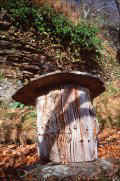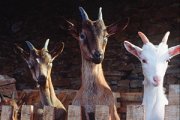The history of agriculture in the Languedoc area
The agriculture (and architecture) in the Languedoc starts about the end of the middle ages.
About the end of the XIIIth century the first farms takes features :
- corn, rye, barley in the plains, oats, a lot of millet, rice. turnip, cabbages, leeks, broad beans
- Tinctorial plants : Garance, Pastel, Gaude.
- Trees : olivier, almond tree, walnut tree for oil, the chestnut in mountain and the mulberry tree of wen the silk appears.
Numerous fruit trees were brought to the Languedoc by thez the crusaders. Orchards take in general only a little part of the cultivated space. The plum and peach tree are the most common ones.
In the Toulouse region olive-trees and of pêchers are planted in the vineyards. Other little by little, adopted fruit trees are : apple, pear, cherry, fig and apricot tree.
Introduction of the sarrazin. Around Toulouse the culture of the pastel has its apogee in first half of the century.
About 1600 corn appears, then the tomato. Massive plantation of olive-trees, walnut trees and almond trees for oil.
The sweet chestnut is very consumed.
Plantation of mulberry trees in relation to the rise of sericiculture.

Progression of the vineyard marks the XVIIth century . Late grape harvest in October. Better conservation of the wine and export becomes possible . Multiplication of distillings.
Decline of corn in Low-Languedoc. The Toulouse corns arrive on the market of Narbonne and Marseilles by "le canal du Midi".
The imported indigo replaces the pastel.
Distillation of the aromatic plants, thyme, aspic, rosemary.
Adaptation of salads, artichokes, cauliflowers, parsley, melons, aubergines, peppers, beans. Cucumbers, pumpkins.
Decline of the olive-tree in Low-Languedoc in second half of the century.
XVIIIth century a second rise of the vine growing. In the Toulouse-region the pastel is abandoned.
Attempt to introduce cotton.
Progressive reduction of the production of rye and the melteil to the profit of various kinds of corns.
Creation of companies of agriculture.
Potato established towards the end of the century. Turnip.
Extension of the artificial meadows.
XIXth century monoculture of the vine in plains.
The use of sulphur for the maintenance of the barrels ensures the conservation of the wine.
Spirits distilled from wine after the crisis of the oïdium in 1850.
Phylloxerna crisis in 1863.
Retreat of rye and the melteil.
Introduction of agricultural mechanization.
Introduction of sugar beet.
Oilseeds like colza, the sunflower, the groundnut are established in vain in the Toulouse region.
Lacked test of reintroduction of the pastel.
Diminution of the cultures of plants textiles:lin and hemp.
Development of the kitchen-gardening
Collapse of the culture of the garance in the Gard.
Exctraction of the olive-trees.
Declin of sericiculture.
In the XXth century the traditionelle poly-culture is given up by the farmers who for the majority are obliged to specialise their product.
It is still praticed by old people and some new-farmers to keep the maximum of autarky, to low costs or like biological(ecological) approach.
Exctraction of the mulberry trees and plantation of vines. Sale of the wine towardsLa Grand Combe with it's prospering mining.
With the lack to obtain a "appellation controlée, exctraction of the vineyeards.
Much of the farmers give up their grounds, others investigates in vegetables.
With the competition of foreign markets the profits are thin. (In 1954 27,3 % of the population is a farmer. In 1975 only 11,6 %)
Some give up agriculture, others will make breeding and pork-butchery.
To improve the economic results, much of the inacessibles terrasses(bancels) inaccessible to machines are left in abandonment. (In 1955 262 ha are managed useful, in 1970 only 151 ha.)
The onion "l'oignon doux" is in progression.
BREEDING
Middle ages : The principal breeding-beasts are goats and pigs; sometimes constituting big communal herds.
Many asses, mules and goats.
The oxen are used for labour.
Pigeons. Geese and chickens in small number.
XVIIth century: the goats constitute large herds
XIXth century::oxen and cows remain with mules and asses, the animals of work, ploughing and transport.
The ovine breeding in increase at the beginning of the century, but decreases at the end.
General regression of breeding.
CAPRINE BREEDING
The practice in the XXth centuryof each family to have one or more goats for its own consumption is still not completely lost. 
The sale of milk and little goats is only started after the Second World War.
In the Seventies many young people began with this breeding in the movement "back to earth".
The stockbreeders decide in 1959 to create the dairy-cooperative with the first French station of testage of the goats and milk.
The fusion with the INRA gave birth to the co-operative of caprine breeding and "Pelardon des Cevennes" in Moissac.
The preferred goat is the goat of the Alps. Either the producers transform the milk at the farm, or they deliver their milk to the co-operative which does the collecting every two days.
SHEEP BREEDING
The stockbreeders of sheep which work for the market gave up marketing wool and milk, except those which deliver their milk for the production of the Roquefort and other regional cheeses.
To shear a sheep costs as expensive as the wool pays.
The majority concentrate on the production of lambs for butchery.
The ewes are rustic races likely to support the rigorous Cevennes winters: "Blanche du Massif Central", "Prealpes", "Lacaune" and "Caussenarde".
The pastures provides the principal food with hy in winter and flour of cereals in the lambing period.
The breeding of the pigs
Most agriculturists after stopping the production of wine, silk, vegetables, started pig- breeding and porkbutcher
A lot of cevenol families also continu the tradition of keeping 1 or some pigs and to transform them for own consumption. This in general with help and a diningfeast with neighbours or friends.
BOVINE BREEDING
This breeding intended for the sale of the meat is done especially on the higher parts of the region, rich of pastures, in Bougès, on the Mont Lozere and in the Aubrac.( 1 cow grazes 4 ha :races : "Croisees de Charolais" and "Aubrac"

OTHER BREEDING:
on a small scale one sees also other breedings: poultry, rabbits, snails, spangled, ostriches, trouts, dogs horses,
OTHER PRODUCTS
Honeies, sweet chestnuts and other fruits, jams, flowers, vegetables, mushrooms, hiring of asses etc.
To complete their income, much farmers make also other work like clearing of undergrowth, school bus services, craft industry, trade, selling wood, the stakes, counts(chestnut), cabinetmaker:(ash, the chestnut, the young elm the oak and the pine). To mulch chairs: (the wicker, the snap) ringpruning, hiring of a lodging, bed and breakfast etc.
The peasant-artisan founded a co-operative of the craftsmen and peasants in 1958 to surch the market for the manufactured objects: . Work of leather, iron, the jewels and potery: exposure and sale in "la maison de la Lozere" in Mende, Montpellier and Paris.

 Campsites
Campsites Hotel-Restaurants
Hotel-Restaurants Hiker's accommodations
Hiker's accommodations Bed & Breakfast
Bed & Breakfast Selfcatering cottages
Selfcatering cottages Group gîtes
Group gîtes Quirky accommodations
Quirky accommodations Holiday villages
Holiday villages